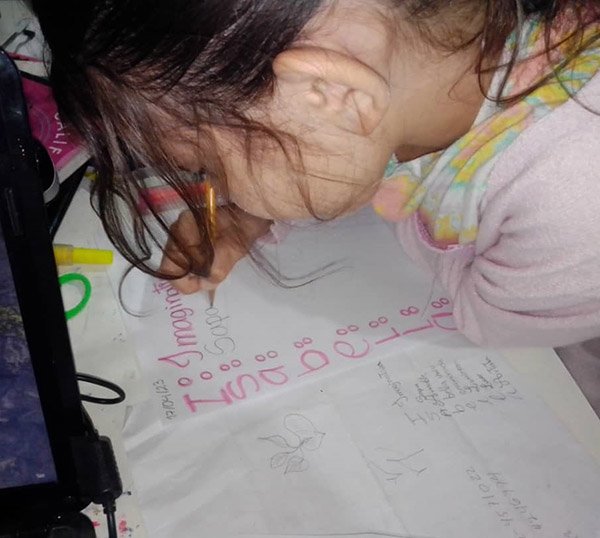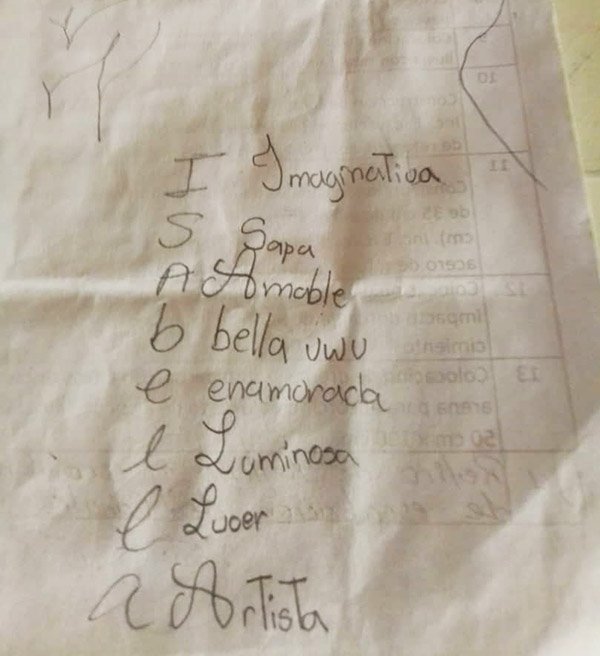Autoconocimiento en el niño. Ejercicio||Self-knowledge in the child. Exercise

Recientemente, tuve la oportunidad de compartir unos días con mis nietas, una adolescente y otra preadolescente de 9 años. Ambas muy activas en la escuela y actividades extracurriculares como la ejecución de instrumentos musicales, la natación o el ballet, cada una haciendo lo que les gusta y sus padres tratando de canalizar lo mejor posible sus intereses, talentos y necesidades.
La menor es muy chispa y habladora y entre los ratos que tuvimos para compartir al escucharla hablar recordé dos ejercicios de autoconocimiento que realizaba con mis hijos y alumnos, le propuse hacerlos y estuvo muy dispuesta, así que buscamos papel y lápiz comenzamos la actividad. Hoy les comparto el primer ejercicio.
Algunos tips para comenzar

*El ejercicio tiene como finalidad que el niño o la persona que lo realiza reconozca y aprecie sus cualidades y/o sus defectos o debilidades, por lo que es conveniente acompañarlo durante el ejercicio, pero dejarlo hacer, no interferir en lo que escribe y solo recordarle a intervalos que tenga presente la frase: “Yo soy”.
*El ejercicio en principio es conveniente hacerlo con el nombre del niño o la niña, pero si su nombre tiene letras, que en nuestro idioma, conseguir palabra con esa letra les resulta complicado, por ejemplo que tenga: W,Y,X, lo más conveniente es conversar previamente con el niño y ayudarlo a encontrar una palabra que le guste mucho, que le suene agradable y se identifique con ella.
El ejercicio
*Comenzamos la actividad escribiendo la frase: Yo soy. Como el asunto me agarró desprevenida, no tuve cuidado en este detalle y agarré el primer papel que tenía a la mano, sin embargo, la idea todo el tiempo estuvo presente y la reforcé en varias oportunidades mientras la niña trabajaba.
*A continuación el niño escribe su nombre colocando las letras de forma vertical, pues la idea es hacer un acróstico donde buscará una palabra con cada una de las letras, palabras que lo describan, y es aquí donde no intervenimos, que él solo encuentre las palabras que expresen como se percibe así mismo.
El trabajo posterior
*Una vez que nuestro niño ha escrito sus “yo soy” conviene conversar sobre cada una de las palabras que lo describen, eso lo ayuda a profundizar un poco más sobre ese quien soy y nos aclara algunas dudas que pudiésemos tener con respecto a las palabras que usó y lo que quería expresar con ellas.
*En este punto es oportuno recordar que no somos psicólogos y no estamos jugando a serlo, somos adultos significativos que queremos que nuestro niño se conozca más así mismo y nosotros conocerlo más a él, por lo tanto, evita juzgar o criticar sus características, solo déjalo expresarse y si consideras que puede ayudarlo, posteriormente, en alguna debilidad mostrada, pues actúa en consecuencia.
Isabella interpretándose

Cuando le pedí a Isabella que me hablara de cada una de sus cualidades muy entusiasmada, me comentó:
*Que ella era muy imaginativa, que le gustaba pintar, soñar e inventarse sus propias historias.
*Con la segunda palabra, yo estaba sorprendida y cuando llegamos allí, le dije cuéntame cómo es eso que eres sapa: la niña riendo me dice que a ella le gusta conocer todo de la gente, de sus amigas y amigos, lo que hacen, que ella era muy curiosa y que quería ser periodista, refutándole un poco le pregunte: pero delatas a los demás, es el chisme lo que te gusta?:
—No abuela, me gusta conocerlo todo para hacer mis historias.
—Entonces, no eres sapa, tal vez curiosa
—Sí, es verdad, pero esa palabra no encaja en mi nombre.
— Ja,ja,ja, buena explicación.
*Expreso que era amable con todo el mundo, y que era muy bella.
*Cuando le tocó el turno a la e de enamorada, también quise explorar más, respondiendo que ella estaba enamorada de sus clases de ballet, de violín, de su teléfono, de sus amigas y amigos y de todo lo que hacía.
*Que era luminosa, que donde ella llegaba sus amigos se alegraban y querían jugar con ella.
*Que era Lucer, como no entendía esta palabra, quise que me explicara que significaba, según ella, era una palabra que se usa mucho y no entendía como yo no sabía que significaba, ja,ja,ja. Me explicó que cuando te dicen que eres un lucer te están diciendo que eres una perdedora.
Significado que me hizo ruido y le comenté que si estaba segura que esa palabra encajaba con lo que ella era, muy compresiva, me recordó que ese día en el juego de futbol de salón en su escuela, ella y su equipo habían perdido y que en eso fueron perdedoras, aunque en muchas otras cosas no. Una respuesta muy convincente.
*Con la última palabra Artista me parece que cerró con broche de oro, pues la describe muy bien.
Ya para cerrar el ejercicio, después que se bañó y descansó, le sugerí pasar en limpio el trabajo realizado y con muy buena disposición lo hizo, le encantó tanto su trabajo que al finalizar fue y lo colocó en la nevera, además estaba tan motivada que aprovecho e hizo el horario de sus actividades extraescolares que era una tarea que tenía pendiente desde hacía meses.

Conclusiones
El ejercicio presentado puede ser muy estimulante para los niños, generalmente, se sienten entusiasmados al tener la oportunidad de buscar dentro de ellos ese “Yo soy” y sobre todo poderlo expresar, reconociendo de esta manera sus fortalezas y debilidades, lo cual, como adulto que dirige la actividad, nos brinda una gran oportunidad para apoyarlos y orientarlos en sus percepciones, canalizando si se puede, sus inquietudes y necesidades, además que crea una fuerte conexión de confianza entre, por ejemplo, padre e hijo, que es positivo cultivar.
Otro aspecto muy importante es escuchar con atención total, pues el niño tratará de explicarnos con las palabras que conoce y domina no solo lo que siente que es, sino también aquellas cosas que le han afectado en algún momento, como es el caso de la famosa palabra “lucer” que aún no sé si realmente existe o mi niña se la creó para que encajara en su acróstico, lo cierto es que en ese momento necesitaba expresar ese sentimiento de “perdedora” que la embargaba.
Evitemos emitir juicios a priori, no supongamos, escuchemos, escuchemos con atención, amor, cariño y respeto.
Si deseas realizar esta actividad con tus hijos y tienes alguna duda sobre el procedimiento, no dudes en preguntar. Estoy por aquí cerquita.

In English

Recently, I had the opportunity to share a few days with my granddaughters, one a teenager and the other a 9-year-old pre-teen. Both very active in school and extracurricular activities such as playing musical instruments, swimming or ballet, each doing what they like and their parents trying to channel as best as possible their interests, talents and needs.
The youngest one is very talkative and sparkling, and between the moments we had to share while listening to her talk I remembered two exercises of self-knowledge that I used to do with my children and students, I proposed her to do them and she was very willing, so we looked for paper and pencil and started the activity. Today I share with you the first exercise.
Some tips to get started

*The purpose of the exercise is that the child or the person doing it recognizes and appreciates his qualities and/or defects or weaknesses, so it is convenient to accompany him during the exercise, but let him do it, do not interfere in what he writes and just remind him at intervals to keep in mind the phrase: "I am".
*In principle, it is convenient to do the exercise with the child's name, but if his or her name has letters, which in our language, it is difficult to find a word with that letter, for example: W,Y,X, it is best to talk to the child beforehand and help him or her to find a word that he or she likes, that sounds pleasant and that he or she identifies with.
The exercise
*The exercise begins by writing the sentence: I am. As the subject caught me off guard, I was not careful about this detail and grabbed the first piece of paper I had at hand, however, the idea was present all the time and I reinforced it several times while the child worked.
*Next the child writes his name placing the letters vertically, because the idea is to make an acrostic where he will look for a word with each of the letters, words that describe him, and it is here where we do not intervene, that he only finds the words that express how he perceives himself.
Subsequent work
*Once our child has written his/her "I am" it is convenient to talk about each of the words that describe him/her, this helps him/her to go a little deeper about who I am and clarifies some doubts we may have about the words he/she used and what he/she wanted to express with them.
*At this point it is appropriate to remember that we are not psychologists and we are not playing at being psychologists, we are significant adults who want our child to know himself better and we want to know him better, therefore, avoid judging or criticizing his characteristics, just let him express himself and if you consider that it can help him, later on, in some weakness shown, then act accordingly.
Isabella interpreting herself

When I asked Isabella to tell me about each of her qualities very enthusiastically, she commented:
*That she was very imaginative, that she liked to paint, dream and make up her own stories.
*With the second word, I was surprised and when we got there, I told her how is it that you are a sapa: the girl laughingly told me that she likes to know everything about people, about her friends, what they do, that she was very curious and wanted to be a journalist, I refuted her a little and asked her: but you tell on others, is gossip what you like?
-So, you are not a sapa, maybe curious?
-Yes, that's true, but that word doesn't fit my name.
- Ha,ha,ha, good explanation.
*She expressed that she was kind to everyone, and that she was very beautiful.
When it was the turn of the e of in love, I also wanted to explore more, answering that she was in love with her ballet lessons, violin lessons, her phone, her friends and everything she did.
That she was bright, that wherever she went her friends were happy and wanted to play with her.
That she was Lucer, as I did not understand this word, I wanted her to explain to me what it meant, according to her, it was a word that is used a lot and she did not understand how I did not know what it meant, ha,ha,ha. She explained to me that when they tell you that you are a lucer they are telling you that you are a loser.
Meaning that made noise to me and I commented to her that if I was sure that this word fit what she was, very understanding, she reminded me that that day in the indoor soccer game at her school, she and her team had lost and that in that they were losers, although in many other things they were not. A very convincing answer.
*With the last word "Artist" I think she closed the exercise with a flourish, because it describes her very well.
To close the exercise, after she bathed and rested, I suggested her to clean up the work she had done and with a very good disposition she did it, she loved her work so much that at the end she went and put it on the fridge, besides she was so motivated that she took advantage of it and made the schedule of her extracurricular activities that was a task she had pending for months.

Conclusion
The exercise presented can be very stimulating for children, generally, they feel excited to have the opportunity to search within them that "I am" and above all to express it, thus recognizing their strengths and weaknesses, which, as an adult who directs the activity, gives us a great opportunity to support and guide them in their perceptions, channeling if possible, their concerns and needs, also creates a strong connection of trust between, for example, parent and child, which is positive to cultivate.
Another very important aspect is to listen with full attention, because the child will try to explain to us with the words he knows and dominates not only what he feels he is, but also those things that have affected him at some point, as in the case of the famous word "lucer" that he could not understand and was the translation of loser to English, the truth is that at that moment he needed to express that feeling of "loser" that overwhelmed him.
Let's avoid making a priori judgments, let's not assume, let's listen, let's listen with attention, love, affection and respect.
If you want to do this activity with your children and you have any doubts about the procedure, don't hesitate to ask. I am close by.

Translated with www.DeepL.com/Translator (free version)
Fuente de imágenes: Archivo personal



MIS REDES SOCIALES





Be Entrepreneur



Hola @damarysvibra !!! Me encantó esa actividad, la pondré en práctica con mi nieto. Gracias por compartir. 🌹🌺🪷🥀🌺💐💐
Me alegro que te haya gustado y que te propongas hacerlo con tu nieto buscando el mejor momento para que ambos disfruten de ese compartir.
Saludos cariñosos y que estés muy bien. 😊
Interesante, me imaginé aplicándola a alguno de mis nietos, es bonito analizar cómo ellos se ven a sí mismos y nos da pistas también de cualquier cosa que les pudiera estar pasando. No juzgamos pero sí podríamos intervenir cuidadosamente para ayudar si hiciera falta. Todo lo que promueva la comunicación con los niños es agradable.
Saludos, amiga.
Así es amiga, abrir esos canales de comunicación es importante, como dices la actividad los ayuda a ellos y a nosotros para comprenderlos mejor y orientar en aquello que creamos conveniente.
Saludos @charjaim, deseándote un gran momento cuando lo apliques. 😊
Hola amiga, muy buen ejercicio para desarrollar mas ese concomimiento de si mismo.
Saludos @nubra11 gracias por pasar y comentar. 😊
Es un ejercicio muy significativo para el adulto y/o padre que acompaña al niño, poder explorar desde sus palabras identificadoras lo que piensa respecto a si misma, le da un mayor espacio para conocerse ella misma y conocerla a ella desde una mirada externa. Me agrada mucho tu iniciativa.
Hola @tibaire me alegro que la actividad te pareciera de valor, Me parece que poner a los niños a reflexionar sobre si mismos y el mundo que los rodea les aporta muchas herramientas para su futuro.
Saludos cariñosos. 😊
Hola @damarysvibra qué linda actividad para indagar y conocer un poco más de los más pequeños, aunque también se puede usar para conocerse un poco más de uno mismo. Saludos
Me encantó esta estrategia. Se las voy a aplicar a los gemelos, quiero hacer ese experimento y ver que piensan de ellos mismos. Gracias por compartir @damarysvibra!
@damarysvibra me encanta este ejercicio que nos muestras. Jugandito pintandito podemos atajar a tiempo el autoconcepto que tienen nuestros niños y si es necesario guiarlos para que resignifiquen y saquen más luz de su ser.
Bella tu nieta!!!🌷
Este ejercicio está maravilloso, me encantó! Lo voy a implementar con mi hijo 😍
@tipu curate 8
Upvoted 👌 (Mana: 0/75) Liquid rewards.